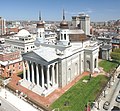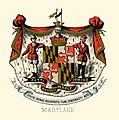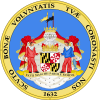|
Maryland Portal
|
Baltimore Task Force
|
Frederick Task Force
|
Montgomery Task Force
|
WikiProject Maryland
|
|
Main page
|
Discussion
|
Introduction Maryland (US: /ˈmɛrɪlənd/ ⓘ MERR-il-ənd) is a state in the Mid-Atlantic region of the United States. The state borders Virginia to its south, West Virginia to its west, Pennsylvania to its north, Delaware to its east, the Atlantic Ocean, and the national capital of Washington, D.C. With a total area of 12,407 square miles (32,130 km2), Maryland is the ninth-smallest state by land area, and its population of 6,177,224 ranks it the 18th-most populous state and the fifth-most densely populated. Maryland's capital is Annapolis, and the most populous city is Baltimore. Occasional nicknames include Old Line State, the Free State, and the Chesapeake Bay State. It is named after Henrietta Maria, the French-born queen of England, Scotland, and Ireland during the 17th century. The western portion of the state contains numerous stretches of the Appalachian Mountains, the central portion is primarily composed of the Piedmont, and the eastern side of the state makes up a significant portion of Chesapeake Bay. Maryland's coastline was first explored by Europeans in the 16th century. Prior to that, it was inhabited by several Native American tribes, mostly the Algonquian peoples and, to a lesser degree, Iroquoians and Siouans. As one of the original Thirteen Colonies of England, Maryland was founded by George Calvert, 1st Baron Baltimore, a Catholic convert who sought to provide a religious haven for Catholics persecuted in England. In 1632, Charles I of England granted Lord Baltimore a colonial charter, naming the colony after his wife, Henrietta Maria. Unlike the Pilgrims and Puritans, who rejected Catholicism in their settlements, Lord Baltimore envisioned a colony where people of different religious sects would coexist under the principle of toleration. (Full article...) This is a Featured article, which represents some of the best content on English Wikipedia..
 The Wire is an American crime drama television series created and primarily written by American author and former police reporter David Simon. The series was broadcast by the cable network HBO in the United States. The Wire premiered on June 2, 2002, and ended on March 9, 2008, comprising 60 episodes over five seasons. The idea for the show started out as a police drama loosely based on the experiences of Simon's writing partner Ed Burns, a former homicide detective and public school teacher. Set and produced in Baltimore, Maryland, The Wire introduces a different institution of the city and its relationship to law enforcement in each season while retaining characters and advancing storylines from previous seasons. The five subjects are, in chronological order; the illegal drug trade, the port system, the city government and bureaucracy, education and schools, and the print news medium. Simon chose to set the show in Baltimore because of his familiarity with the city. (Full article...)General imagesIn the news
On this day...The Maryland portal currently doesn't have any anniversaries listed for April 25. You can help by viewing the page source of an existing entry at /On this day to see how the entries should be formatted, then adding the missing entry. This is a Good article, an article that meets a core set of high editorial standards.
The music of Baltimore, the largest city in Maryland, can be documented as far back as 1784, and the city has become a regional center for Western classical music and jazz. Early Baltimore was home to popular opera and musical theatre, and an important part of the music of Maryland, while the city also hosted several major music publishing firms until well into the 19th century, when Baltimore also saw the rise of native musical instrument manufacturing, specifically pianos and woodwind instruments. African American music existed in Baltimore during the colonial era, and the city was home to vibrant black musical life by the 1860s. Baltimore's African American heritage to the start of the 20th century included ragtime and gospel music. By the end of that century, Baltimore jazz had become a well-recognized scene among jazz fans, and produced a number of local performers to gain national reputations. The city was a major stop on the African American East Coast touring circuit, and it remains a popular regional draw for live performances. Baltimore has produced a wide range of modern rock, punk and metal bands and several indie labels catering to a variety of audiences. Music education throughout Maryland conforms to state education standards, implemented by the Baltimore City Public School System. Music is taught to all age groups, and the city is also home to several institutes of higher education in music. The Peabody Institute's Conservatory is the most renowned music education facility in the area, and has been one of the top nationally for decades. The city is also home to a number of other institutes of higher education that have music programs, the largest being nearby Towson University. The Peabody sponsors performances of many kinds, many of them classical or chamber music. Baltimore is home to the Baltimore Opera and the Baltimore Symphony Orchestra, among other similar performance groups. Major music venues in Baltimore include the nightclubs and other establishments that offer live entertainment clustered in Fells Point and Federal Hill. (Full article...)Selected article -Maryland is a U.S. state with a musical heritage that dates back to the Native Americans of the region and includes contributions to colonial era music, modern American popular and folk music. The music of Maryland includes a number of popular musicians, folk styles and a documented music history that dates to the colonial archives on music from Annapolis, an important source in research on colonial music. Famous modern musicians from Maryland range from jazz singer Billie Holiday to pop punk band Good Charlotte, and include a wide array of popular styles. Modern Maryland is home to many well-regarded music venues, including the Baltimore Symphony Orchestra and Baltimore Opera, and the Peabody Institute's Conservatory of Music. Baltimore, the largest city in the state, is home to many important local venues, such as the Red Room, a center for the local experimental music scene, and the house nightspot Club Choices. Outside of Baltimore, Frederick's Weinberg Center for the Arts and Rockville's Strathmore are also important regional venues. The Merriweather Post Pavilion and 1st Mariner Arena host most of the largest concerts in the area. Since HFStival ended its successful run in 2006, Virgin Festival has taken over as one of the most popular summer festivals on the east coast since its inaugural year in 2006. (Full article...)Did you know?

SubcategoriesSelect [+] to view subcategories
TopicsRelated portalsAssociated WikimediaThe following Wikimedia Foundation sister projects provide more on this subject:
Discover Wikipedia using portals |





















































